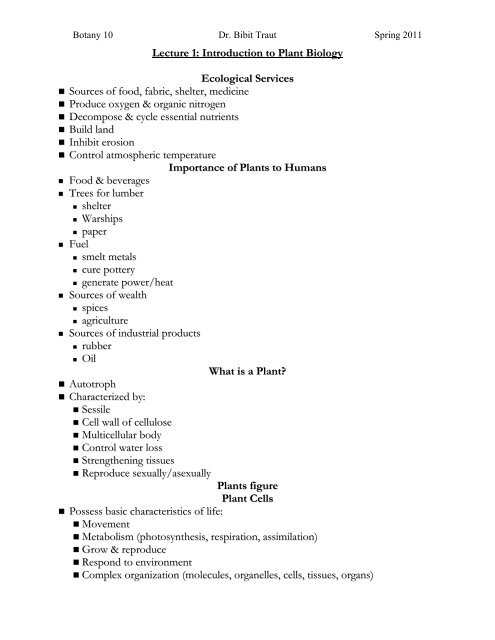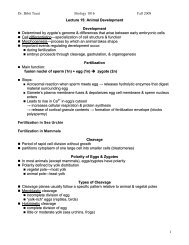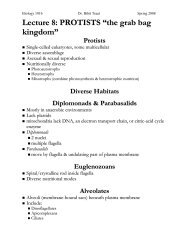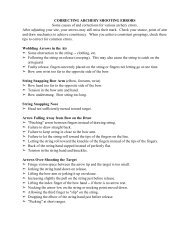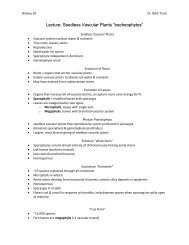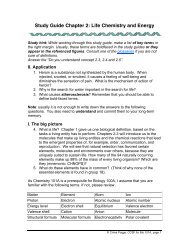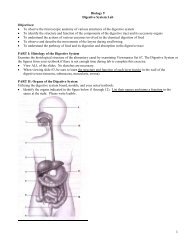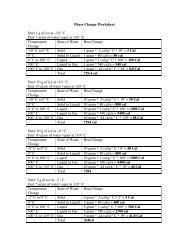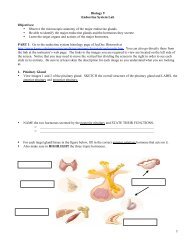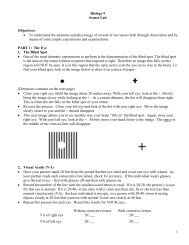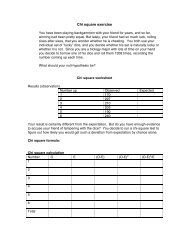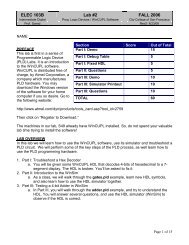Introduction to Plant Biology - Fog.ccsf.edu
Introduction to Plant Biology - Fog.ccsf.edu
Introduction to Plant Biology - Fog.ccsf.edu
You also want an ePaper? Increase the reach of your titles
YUMPU automatically turns print PDFs into web optimized ePapers that Google loves.
Botany 10 Dr. Bibit Traut Spring 2011Lecture 1: <strong>Introduction</strong> <strong>to</strong> <strong>Plant</strong> <strong>Biology</strong>Ecological Services• Sources of food, fabric, shelter, medicine• Produce oxygen & organic nitrogen• Decompose & cycle essential nutrients• Build land• Inhibit erosion• Control atmospheric temperatureImportance of <strong>Plant</strong>s <strong>to</strong> Humans• Food & beverages• Trees for lumber• shelter• Warships• paper• Fuel• smelt metals• cure pottery• generate power/heat• Sources of wealth• spices• agriculture• Sources of industrial products• rubber• OilWhat is a <strong>Plant</strong>?• Au<strong>to</strong>troph• Characterized by:• Sessile• Cell wall of cellulose• Multicellular body• Control water loss• Strengthening tissues• Reproduce sexually/asexually<strong>Plant</strong>s figure<strong>Plant</strong> Cells• Possess basic characteristics of life:• Movement• Metabolism (pho<strong>to</strong>synthesis, respiration, assimilation)• Grow & reproduce• Respond <strong>to</strong> environment• Complex organization (molecules, organelles, cells, tissues, organs)
Botany 10 Dr. Bibit Traut Spring 2011Proteins• regulate chemical reactions in cells, important structural components• Consist of chains of amino acids• Amino acids contain:• Amino group (-NH 2 )• Carboxyl group (-COOH)• R-groupLipids• Fatty or oily substances, mostly insoluble in water• Contain C, H, O (less oxygen than carbohydrates)• Make up plasma membranesNucleic Acids• Vital <strong>to</strong> internal communication & cell functioning• Building blocks of DNAWater• Most abundant molecule in living organisms• Important characteristics• Ability <strong>to</strong> dissolve many compounds• Remains liquid over wide temperature range• Forms weak hydrogen bonds with itself & other moleculesSeparating Inside from Outside• Plasma membrane• Selectively permeable lipid membrane• Surrounds cell• Controls transport in<strong>to</strong>/out of cell• Cell wall• Composed of cellulose (polysaccharide), some with lignin• Functions:• structural strength• limit water absorption• protectionVacuoles• Large compartment surrounded by single membrane• Functions• s<strong>to</strong>res water• regulates turgor pressure inside cell• s<strong>to</strong>res nutrients (e.g. sucrose)• accumulates <strong>to</strong>xic compounds (anti-herbivore)• waste s<strong>to</strong>rage
Botany 10 Dr. Bibit Traut Spring 2011Organelles of Protein Synthesis & Transport• Nucleus• Ribosomes• Endoplasmic Reticulum• Dictyosomes (Golgi Apparatus)• Chloroplasts• Mi<strong>to</strong>chondriaOrganelles of Energy MetabolismBotany As A Science• Science involves the observation, recording, organization, and classification ofinformation.• Study plants for many reasons:• Practical• Applied• Theoretical• Initially interest in plants was practical/appliedScientific Inquiry• Inquiry• A search for information and explanation, often focusing on specific questions• Process of observation & hypothesis testing• Hypothesis (“prediction”)• “tentative answer <strong>to</strong> a well-framed question, an explanation on trial”• testable• falsifiableTheories in Science• A scientific theory• Is broad in scope• Generates new hypotheses• Is supported by a large body of evidenceThe Study of <strong>Plant</strong>s• <strong>Plant</strong> Ana<strong>to</strong>my: internal plant structure• <strong>Plant</strong> Physiology: plant function• <strong>Plant</strong> Morphology: plant form & structure• <strong>Plant</strong> Taxonomy & Systematics: plant classification & evolutionary relationships• <strong>Plant</strong> Geography: plant distributions• <strong>Plant</strong> Ecology: interaction of plants & their environment• Economic Botany & Ethnobotany: practical plant use
Botany 10 Dr. Bibit Traut Spring 2011Why Study <strong>Plant</strong> <strong>Biology</strong>?• Show interrelationships between plants & other fields of study• Prepare for careers in plant biology• Gain fundamental knowledge for upper division plant biology courses• Share expertise gained with nonbotanists• etc…Challenge for 21 st CenturyWhile the human population increases, the major challenge of retaining naturalbiological diversity and developing a sustainable use of the world’s forests,grasslands, and cropland remains. As you study plant biology, think of the waysthat you can contribute <strong>to</strong> this challenge.


